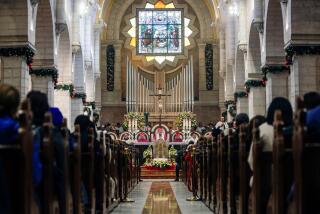‘Christmas’ in trenches of the war
- Share via
In his poem “Anthem for Doomed Youth,” World War I poet and British infantry officer Wilfred Owen ponders the slaughter on the Western Front:
What passing bells for these who die like cattle?
Only the monstrous anger of the guns.
A top-notch History Channel documentary that airs tonight at 8, “The Christmas Truce” tells of an extraordinary moment in December 1914 when the monstrous anger ceased briefly and deadly enemies came together amid the blood-soaked and corpse-strewn battlefield.
The war was only five months old and already bogged in the horrors of trench-warfare stalemate when British and German soldiers along a portion of the front stopped fighting on Christmas Eve. In their trenches just hundreds of yards apart, they began singing.
“In some places, there were even instances when both sides along No Man’s Land were singing the same hymn or carol, in different languages at the same moment,” said Yale historian Patrick Keefe.
A German soldier approached the enemy lines with a small Christmas tree. British Tommies responded. Slowly in stretches along the 600-mile front from the North Sea to Switzerland, the two sides were enjoying a weary timeout.
With historic photos, re-creations and a smattering of historians and archivists, “Truce” provides a detailed and moving account of the cease-fire that lasted just hours in some places, days in others, and was ignored altogether in some stretches where the killing continued apace.
Officers on both sides were appalled at the truce and threatened punishment, even execution if their troops did not return to the trenches. In defiance, a soccer game broke out.
“All those young boys, they were not made to kill each other,” said Annette Linthout, a guide at a museum at Ypres, Belgium. “They were afraid of each other.”
“Truce” is strongest in its evocation of war in the trenches: the cold, the fog, knee-deep water, trench foot that turned to gangrene. It is soggiest when trying to fit the story into some Big Picture meaning as a 20th century turning point.
More to Read
Sign up for Essential California
The most important California stories and recommendations in your inbox every morning.
You may occasionally receive promotional content from the Los Angeles Times.












